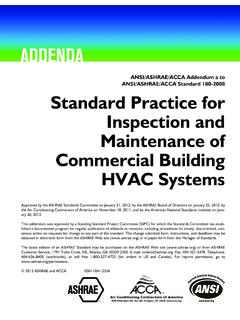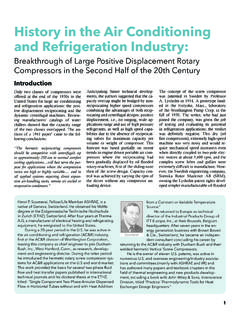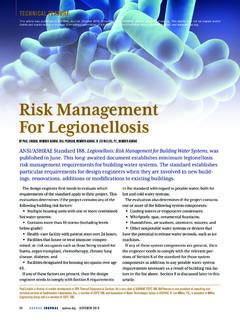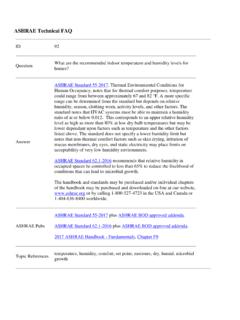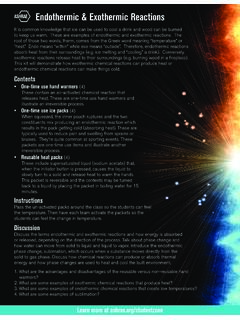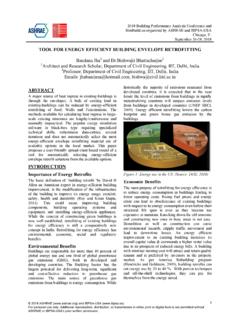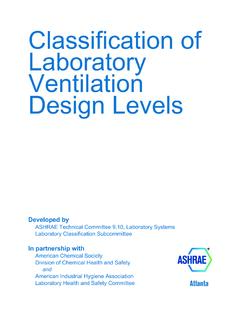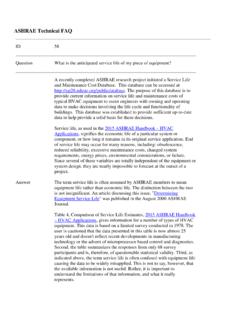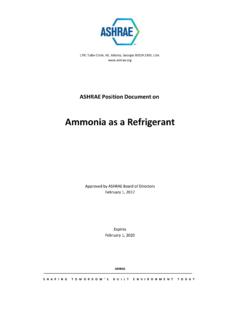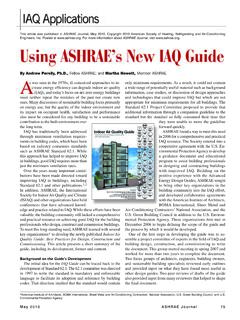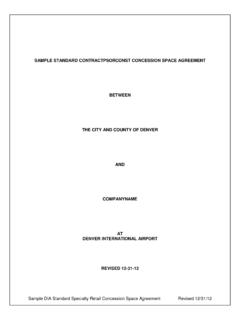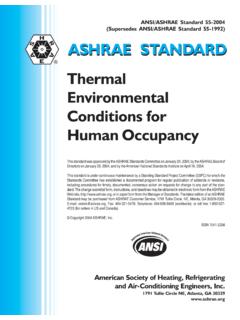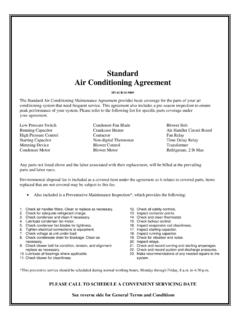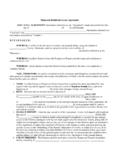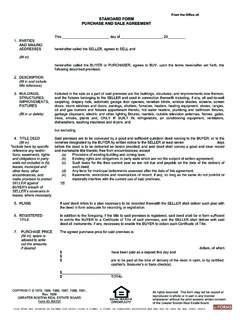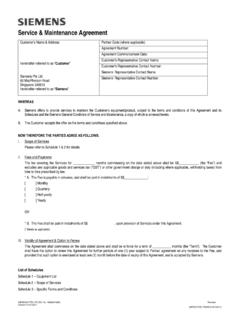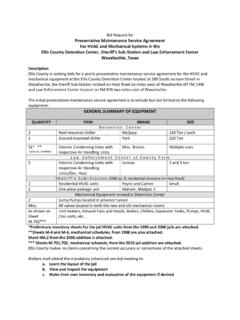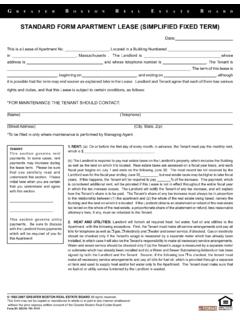Transcription of Standard Method of Test for the Evaluation of Building ...
1 ANSI/ASHRAE Addendum a toANSI/ASHRAE Standard 140-2001 Standard Method of Testfor the Evaluation ofBuilding Energy AnalysisComputer ProgramsApproved by the ASHRAE standards Committee on June26, 2004; by the ASHRAE Board of Directors on July 1,2004; and by the American National standards Instituteon July 1, Standard is under continuous maintenance by aStanding Standard Project Committee (SSPC) for whichthe standards Committee has established a documentedprogram for regular publication of addenda or revisions,including procedures for timely, documented, consensusaction on requests for change to any part of the change submittal form, instructions, and deadlinesare given at the back of this document and may be ob-tained in electronic form from ASHRAE s Internet HomePage, , or in paper form from theManager of standards .
2 The latest edition of an ASHRAES tandard and printed copies of a public review draft maybe purchased from ASHRAE Customer Service, 1791 TullieCircle, NE, Atlanta, GA 30329-2305. Fax: 404-321-5478. Telephone: 404-636-8400 (worldwide), or toll free 1-800-527-4723 (for or-ders in and Canada). Copyright 2004 American Society of Heating,Refrigerating and Air- conditioning Engineers, 1041-2336 SPECIAL NOTEThis American National Standard (ANS) is a national voluntary consensus Standard developed under the auspices of the AmericanSociety of Heating, Refrigerating and Air- conditioning Engineers (ASHRAE). Consensus is defined by the American National StandardsInstitute (ANSI), of which ASHRAE is a member and which has approved this Standard as an ANS, as substantial agreement reachedby directly and materially affected interest categories.
3 This signifies the concurrence of more than a simple majority, but not necessarilyunanimity. Consensus requires that all views and objections be considered, and that an effort be made toward their resolution. Compliance with this Standard is voluntary until and unless a legal jurisdiction makes compliance mandatory through obtains consensus through participation of its national and international members, associated societies, and standards are prepared by a Project Committee appointed specifically for the purpose of writing the Standard . TheProject Committee Chair and Vice-Chair must be members of ASHRAE; while other committee members may or may not be ASHRAE members, all must be technically qualified in the subject area of the Standard . Every effort is made to balance the concerned interestson all Project Committees.
4 The Manager of standards of ASHRAE should be contacted for:a. interpretation of the contents of this Standard ,b. participation in the next review of the Standard ,c. offering constructive criticism for improving the Standard ,d. permission to reprint portions of the INDUSTRIAL ADVERTISING POLICY ON STANDARDSASHRAE standards and Guidelines are established to assist industry and the public by offering a uniform Method of testing for rating purposes, by suggesting safe practices in designing and installing equipment, by providing proper definitions of this equipment, and by providing other information that may serve to guide the industry. The creation of ASHRAE standards and Guidelines is determined by the need for them, and conformance to them is completely referring to this Standard or Guideline and in marking of equipment and in advertising, no claim shall be made, eitherstated or implied, that the product has been approved by uses its best efforts to promulgate standards and Guidelines for the benefit of the public in light of availableinformation and accepted industry practices.
5 However, ASHRAE does not guarantee, certify, or assure the safety orperformance of any products, components, or systems tested, installed, or operated in accordance with ASHRAE s Standardsor Guidelines or that any tests conducted under its standards or Guidelines will be nonhazardous or free from standards COMMITTEE 2003-2004 Van D. Baxter, ChairDavor Novosel, Vice-ChairDonald B. BivensDean S. BorgesPaul W. CabotCharles W. Coward, F. CrowtherBrian P. DoughertyHakim ElmahdyMatt R. HarganRichard D. HermansJohn F. HoganFrank E. JakobStephen D. KennedyDavid E. KnebelFrederick H. KohlossMerle F. McBrideMark P. ModeraCyrus H. NasseriGideon ShavitDavid R. TreeThomas H. WilliamsJames E. WoodsRoss D. Montgomery, BOD ExOKent W. Peterson, COClaire B. Ramspeck, Manager of StandardsASHRAE Standard Project Committee 140 Cognizant TC: TC , Energy CalculationsSPLS Liaison: Matt R.
6 HarganRonald D. Judkoff, Chair*David E. Knebel*Joel Neymark, Vice-ChairSimon J. Rees*Ian Beausoleil-Morrison*George N. Walton*Drury B. Crawley*Bruce A. Wilcox*Philip W. Fairey, III*Frederick C. Winkelmann*Jeff S. HaberlMichael J. Witte**Denotes members of voting status when the document was approved for publicationBSR/ASHRAE Addendum a to ANSI/ASHRAE Standard 140-20011(Note: Additions are shown in this addendum by underliningand deletions are shown by strikethrough except when aninformative note makes it clear that the entire material thatfollows is to be added or deleted as a whole.)CONTENTS [Informative Note: Revise the table of contents as indicated.]Foreword , Abbreviations and Acronyms of RequirementsNormative AnnexesAnnex A1 Weather DataAnnex A2 Standard Output ReportsInformative AnnexesAnnex B1 Tabular Summary of Test CasesAnnex B2 About Typical Meteorological Year (TMY)
7 Weather Data Annex B3 Infiltration and Fan Adjustments for AltitudeAnnex B4 Exterior Combined Radiative and ConvectiveSurface CoefficientsAnnex B5 Infrared Portion of Film CoefficientsAnnex B6 Incident Angle Dependent Window Optical Prop-erty CalculationsAnnex B7 Detailed Calculation of Solar FractionsAnnex B8 Example ResultsAnnex B9 Diagnosing the Results Using the Flow DiagramsAnnex B10 Instructions for Working with Results Spread-sheets Provided with the StandardAnnex B11 Production of Example ResultsAnnex B12 Temperature Bin Conversion ProgramAnnex B13 COP Degradation Factor (CDF) as a Function ofPart Load Ratio (PLR)Annex B14 Cooling Coil Bypass FactorAnnex B15 Indoor Fan Data EquivalenceAnnex B16 Quasi-Analytical Solution Results and ExampleSimulation Results for HVAC Equipment Performance TestsAnnex B17 Production of Quasi-Analytical Solution Resultsand Example Simulation ResultsAnnex B183 Validation Methodologies and Other ResearchRelevant to Standard 140 Annex B194 References(This foreword is not part of this Standard .)
8 It is merelyinformative and does not contain requirements necessaryfor conformance to the Standard . It has not been pro-cessed according to the ANSI requirements for a stan-dard and may contain material that has not been subjectto public review or a consensus process.)[Informative Note: This new foreword replaces the previousforeword.]FOREWORDThis Standard Method of Test (SMOT) can be used foridentifying and diagnosing predictive differences from wholebuilding energy simulation software that may possibly becaused by algorithmic differences, modeling limitations, inputdifferences, or coding errors. The current set of tests includedherein consists of comparative tests that focus on Building thermal enve-lope and fabric loadsand analytical verification tests that focus on mechanicalequipment performance.
9 These tests are part of an overall validation methodologydescribed in Annex procedure tests software over a broad range of para-metric interactions and for a number of different output types,thus minimizing the concealment of algorithmic differences bycompensating errors. Different Building energy simulationprograms, representing different degrees of modeling complex-ity, can be tested. However, some of the tests may be incompat-ible with some Building energy simulation tests are a subset of all the possible tests that couldoccur. A large amount of effort has gone into establishing asequence of tests that examine many of the thermal models rel-evant to simulating the energy performance of a Building andits mechanical equipment. However, because Building energysimulation software operates in an immense parameter space,it is not practical to test every combination of parameters overevery possible range of function.
10 The tests consist of a series of carefully described testcase Building plans and mechanical equipment values for the cases are compared and used in con-junction with diagnostic logic to determine the sources of pre-dictive differences. For the Building thermal envelope andfabric load cases of Section , the basic cases ( and ) test the ability of the programs to model suchcombined effects as thermal mass, direct solar gain windows,window-shading devices, internally generated heat, infiltra-tion, sunspaces, and deadband and setback thermostat con-trol. The in-depth cases (Section ) facilitate diagnosisby allowing excitation of specific heat transfer HVAC equipment cases of Section test the ability ofprograms to model the performance of unitary space-coolingequipment using manufacturer design data presented asempirically derived performance maps.
